
|
 |
Kitaplar » AQUACULTURE » Asian Carp Cultıre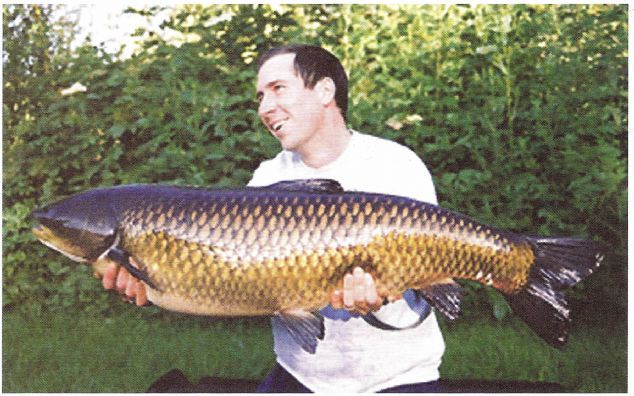 Picture: A grass carp weighing 16 kg. (Ctenopharyngodon idella)
ASIAN CARP
GRASS CARP AND SILVER CARP
(Ctenopharyngodon idella VAL) In Far Eastern countries, especilly the Chinese have been growing fish in ponds for centuries. In addition to common carp breeding in South Asia and the Far East, various carp species are also studied. The first of these are Catla, Cirrhina and Labee species, which are called "Indian Carp", grown in India, Burma and Pakistan. The other group gathers under the name of "Chinese Carp". These are species grown in China, Thailand, Vietnam, Malaysia and Japan. (Ctenopharyngodon idella (Grass carp), Hydpophthalmichthys molitrix (Silver Carp) (feeding on plankton), Aris- tichtys nosilis (feeding on Zooplankton and phytoplankton), Mypopbaryngodon piceus (feeding on mollusks) and Cirrhina molitorella (feeding on mollusks) The first four carp fish from the last group were brought from China to Russia in the 1950s and to Romania in 1956. They have been taken to Hungary and other Eastern European countries since 1960. After the successful implementation of artificial insemination, these species have spread to other European countries and America. The reason for the rapid spread of these species all over the world is that they are fed with herbs and plankton that are not eaten by common carp and other carp species, they grow rapidly, and their meat is delicious. Main Asian carp cultivated in Europe: Grass carp, silvery carp, big-headed carp. These carp are of Chinese origin. They live and are produced in waters with strong currents. They breed when the summer rains puff up the rivers, when the water temperature is between 25-30 degrees and the water is cloudy. The breeding of these fish is of great importance in China. 14.6% of freshwater fish grown in China are carp, 38.4% are silvery carp and large-headed carp. Even the production of grass carp is more than normal carp and is 22%. Chinese breeders and villagers have been breeding these fish mixed for centuries. The offspring of this species are constantly taken to Forrnoza, Malaysia, Japan and other East Asian countries. They are grown until the paint to be consumed arrives. The development of these fish depends on the temperature of the water.
WEED CARP
It has a tall body covered with large scales. Its fins are short and strong. More or less similar to freshwater mullet (Squaliuscephalus L.). It is found in large rivers, from north to south of China, and is considered to have originated from the Amur river. There are those that grow up to 30-40 kg in streams.
Its body length is 3.8- 4.8 times its width. There are also those that are longer than 1 meter. But the average weight is 4-5 kg. 816,000 eggs were obtained from a 7-year-old, 7,4 kg and 76 cm long female fish. Its eggs are pelagic. This fish, which feeds only on grass, can also benefit from algae in the water. For this reason, it is taken to be raised with carp in large areas where fertilization is applied in China and Russia. Until recent years, only offspring caught from rivers could be taken into breeding. But today, it is possible to produce offspring from this fish with hormonal effects. It is beneficial to have especially large ones in the production areas due to the fact that they only eat grass, for combating weeds.
SILVER CARP It has a high back and a round torpedo structure. It is covered with small scales. Its color is silvery white. The abdomen is light white in color and the fins are gray in color. Cubs receive animal plankton (small aquatic creatures) for the first 10-15 days. It then feeds on vegetative plankton (small aquatic plant). Its development is slower than that of carp. Its meat is light white in color and very tasty. Carp fish can reach 800-1,000 gr at the end of 2 years. Cultivation in waters and ponds rich in plants and plankton gives positive results. Its body is covered with small, silver-colored scales. The head is round, the forehead is wide, the eyes are slightly below the muzzle. The gill wires are quite long and resemble a fine filter that can trap planktonic organisms. They feed on blue and green planktonic algae. They are found in nature in rivers and lakes. They spend the winter months at the bottom of rivers, and in the spring they migrate in large flocks if the river they are in is connected to a lake. It has been reported that spawning periods in the Amur River are between the end of May and the beginning of June. The offspring to be cultivated are therefore caught within 6-8 weeks between June and mid-July. It has been determined that their eggs are generally found in the water entering the lakes and they are generally not spawned in the lake (in Lake Amur). They reach maturity at the age of 4-5 in general. Average weight in fish between 5-9 years is between 3 and 4,9 kg. There are also individuals that can reach 20 kg.
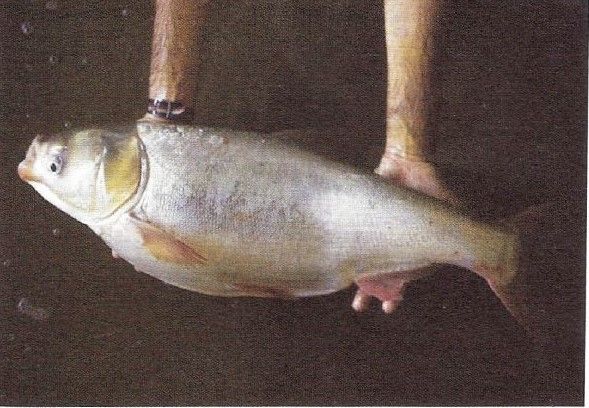 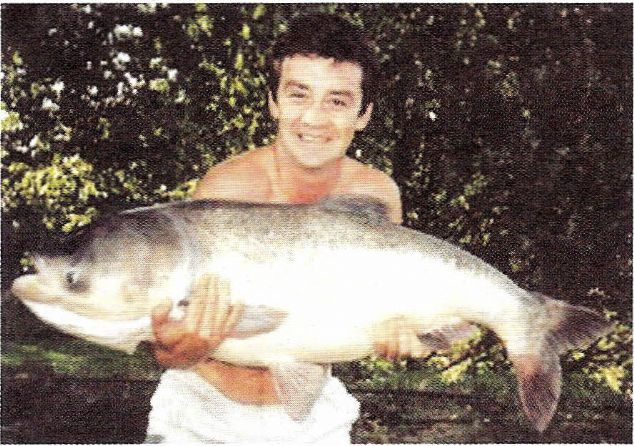 LARGE HEADED CARP
It is similar to silver carp. Its head is larger and its abdomen is more rounded. Its skin color is darker, bright and dark yellow. Gill wires are wider. These fish especially have gill strings that filter very small zooplankton and phytoplankton. If there are plenty of feeds that this species can eat in the environment, its development will be very fast. It is a type of fish farmed with carp fish. It is most commonly grown in China. It has been exported to many countries from China. Polyculture is carried out with catfish in the USA. Catfish is a type of fish that can eat other fish. There is no problem when the same lengths are taken into breeding together. The juvenile production technique in large-headed carp is similar to the production technique in carp. Fish reach sexual maturity at the age of 3-4 years. Males reach sexual maturity earlier than females. Egg retrieval with the effect of hormones is a very common practice. A temperature of 23-26 degrees is optimal for spawning. After the eggs are obtained, they are taken to the juvenile production ponds, which are prepared as in carp farming and in which natural plankton reproduction is ensured through fertilization. The juveniles growing here are stocked with carp to produce 100-200 kg per decare in China. They are stocked with catfish to be grown in the same quantities in the USA. The marketing weight of these fish is 3-4 kg. Since it is a fish with bones, consumption of small fish is not seen well. In large fish, consumption is easier because the bones are relatively ossified. It is stated that the joint production of Big-Headed Carp and catfish farming in the USA makes it possible to generate more income per unit area. Because catfish, a creature that can eat zooplankton and turn it into meat, increases profitability. In a study on this subject, breeding this fish with catfish provides an extra income of 25 to 100 dollars per decare. It ranks fourth among the fish farmed in the world. It is also an important fish in generating an additional income in businesses. Because they evaluate plant foods that catfish do not evaluate and turn them into meat. In some periods, if catfish prices drop, this type of additional income contributes significantly to the economy of the enterprises. Success can be achieved in breeding by bringing it to our country or in breeding with carp. Since its meat has a little bone, it is not very popular in some regions. It is a sought-after species in some countries. The techniques used in breeding are similar to those of carp breeding. There is a slight difference in breeding methods for each species, and these differences play an important role in successful breeding. When the fish reach the age of 3-4, they reach sexual maturity. Males reach sexual maturity earlier than females. The age of reaching sexual maturity may be earlier or later depending on the regions and, depending on this, the temperature of the water. They are very large fish. They can reach a weight of 10-12 kg when they are 4-5 years old. Even 30-35 kg can be found in China.
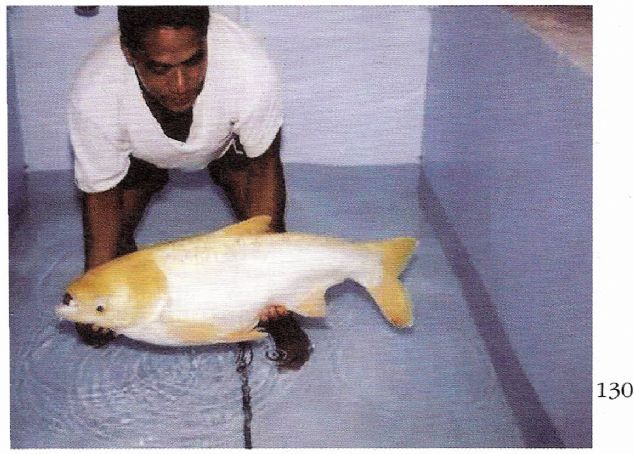 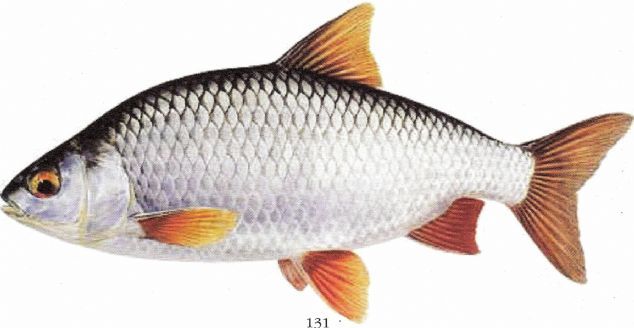 Top: Yellow-colored large-headed carp lines were developed by mutation and selection. Bottom: Redeye(Rutilus rutilus or Gardanus rutilus L.) PUPPY PRODUCTION IN CHINESE CARP
Zugar bottles can be used in the production of all three types. Care of broodstock fish is very important. Before the breeding season, it is beneficial to separate the breeding fish and subject them to a special care. In general, it can be stated that breeding times are around the twentieth day. Stud fish are separated as males and females 8-10 days ago. In females, the abdomen is plump and soft. In males, the abdomen has a flatter structure. In order to obtain mature eggs, pituitary application can be done as explained in the section on Carp breeding. After the eggs are fertilized with the sperm taken from the male, the eggs are placed in zugar bottles. 0.8 -1 lt min of water can be given to Zugar bottles. 1/3 eggs can be added to 8-10 liter zugar bottles, or 50g eggs can be placed in each bottle. In 50 grams of fertilized eggs, there are 40,000 eggs in grass carp, 50,000 eggs in silver carp and 30,000 eggs in large-headed carp. The water supplied to the zugar bottles should be sufficient to slightly crumble the eggs. Dead eggs take a dull color 8-10 hours after fertilization. These eggs can be cleaned with the help of a siphon. The larvae that hatch can easily pass from the top of the bottles to the rearing tank. These larvae can be collected with cheesecloth and taken to special breeding places. Various breeding ways can be tried in this regard. These puppies are then taken to special pools enriched in plankton and fed. It is also possible to grow with Artemia larvae. It is recorded that it is grown as an additional product in some regions as it turns the inedible foods by pike, pike, sea bass and even eel into meat. Red eye is an important species especially for lakes. Eye color is reddish. He has teeth in a single row in his throat. There are different races of red eye according to the regions. Body height can also be high or low, depending on the nutritional possibilities in the region. Their growth also depends on the environment. It rarely reaches 40 cm in length and 1 kg in weight. They live in flocks in lakes and stagnant waters, among plants on the shores. There are regional races living in the gulfs of the Black Sea, Aral Lake and the Baltic Sea by entering the low-salt waters and migrating to fresh waters to winter and make eggs. Animal food sources; insect larvae, mollusks and crustaceans. Vegetable food sources are various algae and phytoplankton. They winters by going down to the bottom of the water in the winter season. Red eye lays eggs from the end of April to June. For this, the water temperature must be above 10 degrees. Spawning usually occurs near the shore, in low places and on a gravel surface. The males stay in places where eggs are laid for a few days. A female fish can lay between 5,000 and 200,000 eggs. Eggs are up to 1 mm in diameter. Eggs stick to stones and plants because they are sticky. The incubation period can last 4 - 10 days depending on the temperature of the water. The newly hatched larvae are 4 - 6 mm in length. These larvae live motionless for 2 - 5 days and consume the egg sac. After this period, the juvenile fish approach the shore and feed on zooplankton. When the juvenile reaches 30 mm in length, scales begin to appear. Females grow faster than males. The age of sexual maturity of the red eye is around 3 years old. It may vary by region. MINNOVAL CULTIVATION It is one of the most produced fish species among the aquatic creatures grown in the world. According to 2000 data, it ranks sixth with approximately 1.5 million tons of production. It is called "crucian carp" in English. Its Latin name is "carassius carassius". The largest can reach 60 cm in length and 3 kg in weight. It is a demersal fish. They live in fresh and brackish waters. It is grown in large quantities in rice fields in China. In such areas, their size is smaller and their weight is between 250-500 grams. They are used as food. Small fry are used as live bait in fishing. They do not like very hot waters. Lakes and other waters at a temperature of 14-22 degrees are suitable for their lives. They are common from Europe to China.
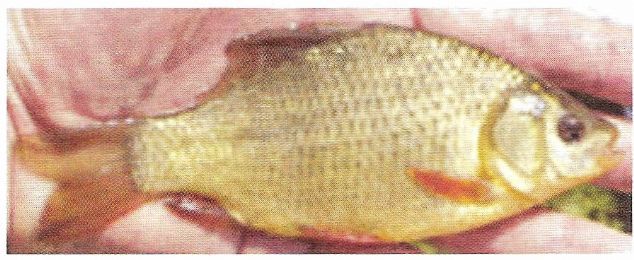 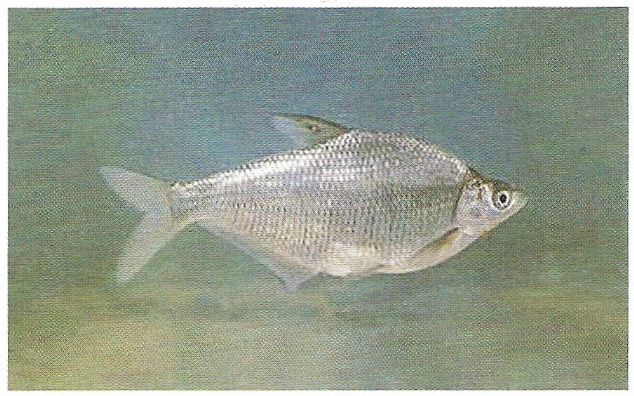 Top: Minnow (Carassius carassius) Bottom: White Amur Sea Bass (Parabramis pekinensis)
WHITE AMUR SEA BASS (parabramt speleinensis)
With 520 thousand tons of production, it is the sixteenth among the living creatures in the world. Therefore, it can be said that it has an important place in fish farming. It can also be called minnov. They can reach 55 cm in length and 4 kg in weight. They are freshwater fish and generally live in 10-20 m deep waters. They prefer to live in deep and middle waters. Its flesh is considered delicious and has a lot of awning. It is an important species for both fishing and aquaculture in China. In aquaculture studies, there is a similar application technique to carp farming. MUD SCREEN (Cirrhinus motitorella) It ranks 23th among the cultivated species in the world. In 2000, around 270,000 tons were grown. It is mostly a by-product in carp farming, but due to the large amount of production, it is an important breeding product for many countries. BLACK AMUR CARBON (Mylopharyngodon piceus)
It is among the 30 most cultivated species in the world. It is cultivated around 190,000 tons. It is considered among the Chinese carp. It can grow to very large sizes. It is reported that those 122 cm in height and 32 kg in weight were caught.
THE GIANT SIYAM SCAR (Catlocarpio siamensis) It is the largest among the fish known under the name carp. They can reach a weight of 80-90 kg. For this reason, it is a fish species whose hunting is very exciting. Touristic trips are organized for the fishing of this fish. For this reason, specially grown fish are left to some hunting areas for hunting purposes and are taken to grow by other fish breeders. Tourists hunt in Thailand and in ponds located near Bangkok.
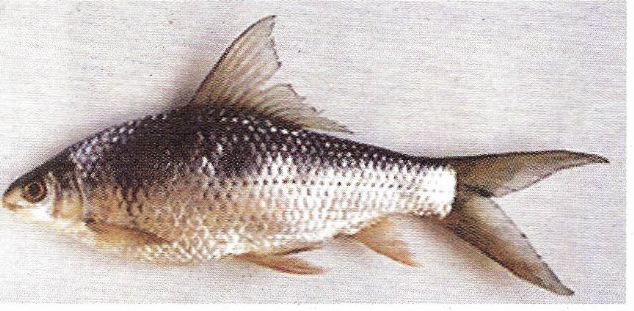 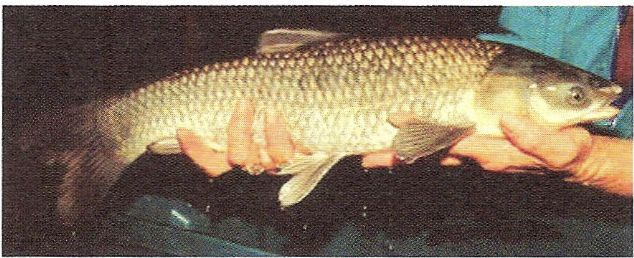 Top: Mud carp (cirrbinus molitorella) Bottom: Black Amur Carp (Mylopbaryngodon piceus) GREEN CARP (Tinca tinca L.)
Green carp usually live in still waters, lakes and ponds with abundant vegetation. It is also called velvet fish. It is a species that mostly wrangles. It is found in rivers flowing into the Black Sea in our country and in some parts of Thrace and Central Anatolia. Its meat is stringy, firm and delicious. It has no commercial value in our country, but it is marketed at the price of trout in Europe and its consumption habit is common. For this reason, it is cultivated together with carp. This fish is called velvet fish. Its body is dark green or dark green. Their fins are round and their scales are dark. Its skin is thick and slippery. There are 2 mustache on the back of his mouth. In nature, it can reach 70 cm in length and 8 kg in weight. In males who have reached sexual maturity, the second ray of their fins gets longer and larger. It reaches up to the anus. Occasionally, it is seen to live in slightly salty waters. Spawning takes place when the water temperature is 19-20 degrees. They choose shallow water with plenty of plants to lay their eggs. The weight of green carp to be used as rootstock varies between 0.5-1.5 kg. Male and female can be easily distinguished from each other even outside the breeding season. Because males have longer abdominal fins than females. It extends into the anus cavity. These fins are shorter in females. Green carp begins to spawn when it is 3-4 years old in European conditions. The spawning time is between April and July. Female green carp weighing 500 grams lays up to 300,000 eggs. This number can reach up to 1 million in old and large rootstocks. The diameter of the eggs varies between 0.8 and 1.2 mm. The ovulation process can continue for up to 2 months at two-week intervals. The eggs are at the bottom of the water or attached to the plants. After 100-120 degree days (5-6 days) from fertilized eggs, offspring begins to hatch. The size of the newly hatched larvae is 4-5 mm. The larvae seem to be attached to the plants in the first days. At 10 days of age, the egg sac disappears and the larvae begin to take feed. The larvae that feed on plankton in the first days begin to take other feeds as they grow. Green carp, which are raised together with common carp, are also bred with red eye (Rutilis rutilis) in some farms. Some of the pools where green carp are grown are shallow and some are deep. It is desirable to have plenty of plants in the pool and to have plenty of incoming sunlight.
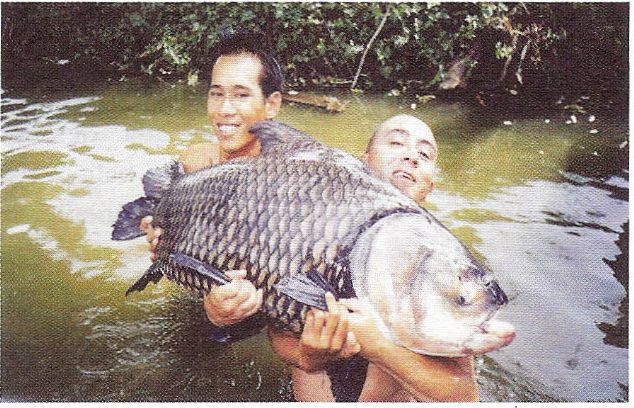 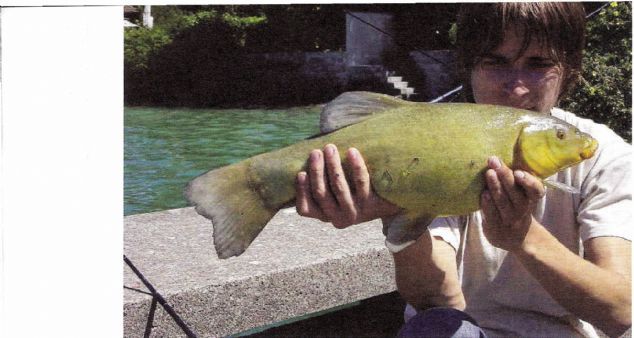 Top: Giant Siamese Carp (Catlocarpio siamensis) Bottom: Green Carp (Velvet Fish) Carp fish farming in our country is a field of occupation that has just begun. Green carp production has not been done to this day. In the production of green carp in Central Europe, juvenile breeding is either applied in production ponds for common carp or special pools are used. The ponds built for the production of green carp fry are 2 - 2.5 decares and 4 - 6 female fish and 8 - 12 male fish should be placed here in spring. These pools are emptied at the end of August and 3-5 cm long juveniles are taken into production pools. Development in offspring can vary depending on environmental conditions. We have stated that green carp production for consumption is generally done with common carp. In general, common carp and green carp show similar nutritional characteristics. The ratio should be well regulated in the number of fish placed. Because development in green carp is slower than common carp. The ratio of carp should be higher. Green carp can be 20-25%. Green carp production is also carried out for stocking purposes in Central Europe. If common carp and red eye are used in stocking, it is recommended to stock these three fish equally at 1/3 rate.
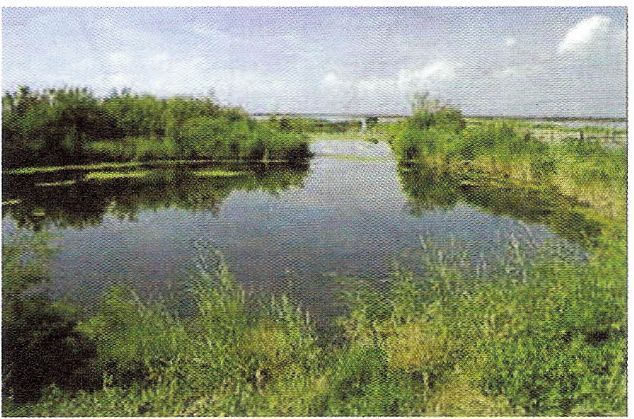 Picture: Green carp is a by-product in carp farming, especially in large areas. They are grown in ponds with muddy floors and grass.
|




